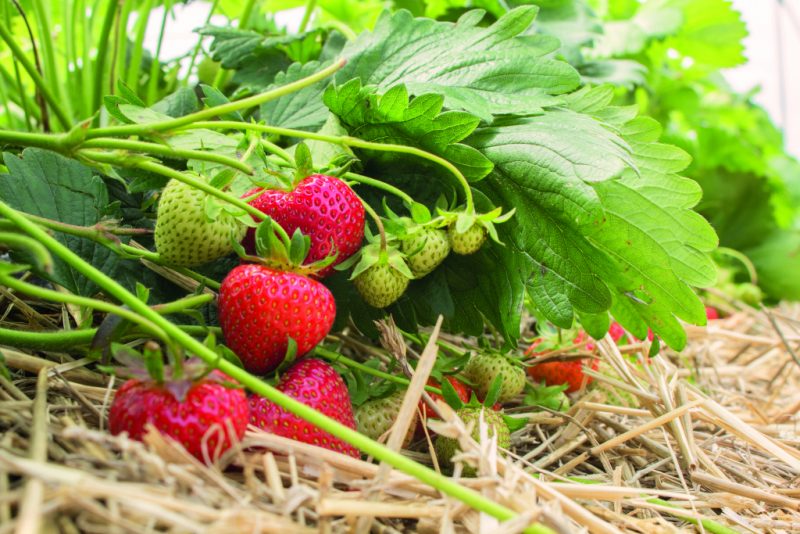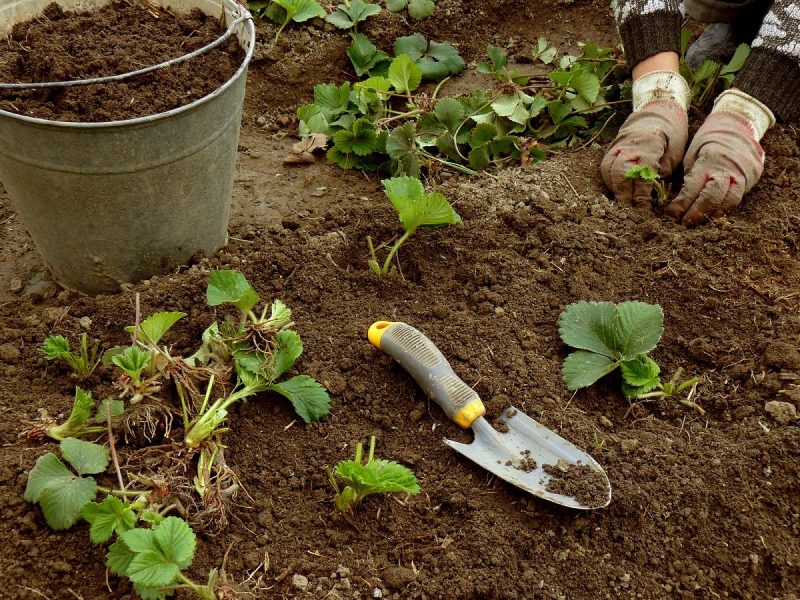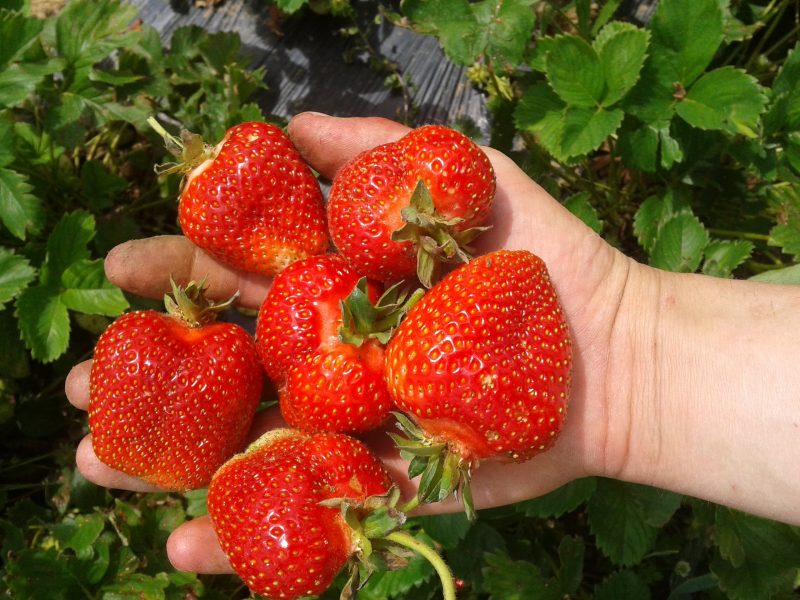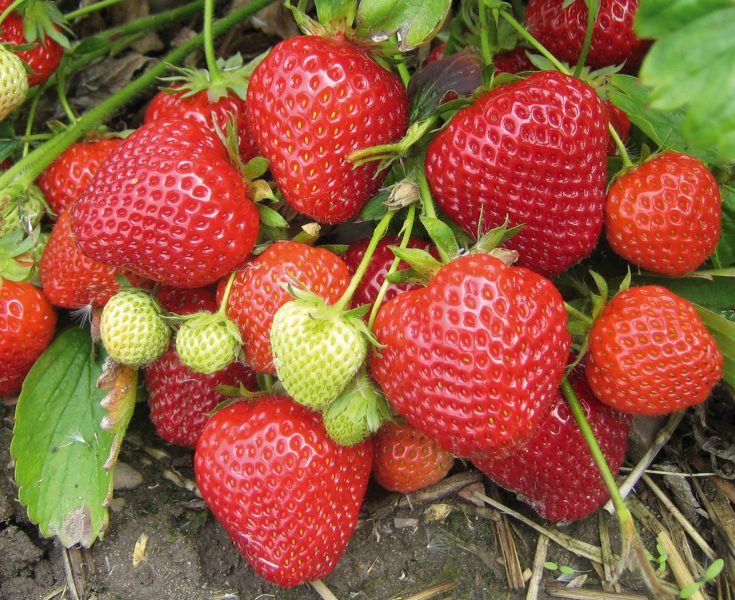Choosing a good strawberry for their site, gardeners prefer high-yielding varieties with large berries, tasty and aromatic. Elsant strawberries with proper care will live up to the wildest expectations. You will find a description of the variety and features of agricultural cultivation techniques in the article.
Material Content:
Description and features of the variety
Elsanta is a Dutch variety of medium early ripening. For a long time it was a reference in Europe due to its excellent characteristics. He appeared as a result of crossing wild strawberries Garden Holiday and Gorella in 1981.
Description of Elsant Strawberry:
- berries are large, bright red cone-shaped, regular in shape with a large number of yellow seeds on the surface, have a good presentation, weight 1 pc. - from 35 to 50 g;
- the berries taste delicious, juicy, sweet with a slight sour flavor, easy to transport due to the dense pulp;
- average yield, from 1 m2 you can collect 2 kg of strawberries per season;
- compact bushes;
- light green leaves are slightly twisted, with a slight pubescence;
- little mustache is formed;
- peduncles strong, high.
The fruiting period of the variety is extended - from late May to July. Strawberries hibernate well, in very cold winters it needs shelter.
Growing seedlings from seeds
Elsant hybrid strawberry seedlings can only be grown from seeds purchased at the store. With independent collection of seeds, nothing will work. Plants will not inherit the characteristic features of the variety - large berries with excellent taste. Growing seedlings from seeds is troublesome, but there was nowhere to buy seedlings - this is the only way to get the desired variety of plants.
A step-by-step description of the process of growing strawberries from seeds:
- For planting, prepare small plastic containers with transparent covers, fertile light soil, a solution of fungicide (Fitosporin), seeds from the store and phytolamp.
- It is better to take the soil purchased, purified from harmful microorganisms. If this is land from the site, it is baked for several hours in the oven at a temperature of 100 ° C.
- Holes are made in the landing tank at the bottom so that excess moisture leaves. Pour prepared soil, moisten from a spray with a solution of Fitosporin.
- Strawberry seeds are poured from the bag onto a white sheet of paper and laid out with a toothpick on the soil surface at a distance of 2 cm from each other.
- Once again slightly moisten the soil from the spray gun - gently so as not to wash off the seeds. Cover the container with a lid or a transparent bag and put in a warm place. The air temperature for successful germination must be +25 ° C.
- When the first strawberry sprouts appear, they remove the lid from the landing container, put it under a phytolamp, away from drafts. Do not forget to moisten the spray bottle with room temperature water.
- Seedlings are dived into separate cups at the stage of 2 real leaves.
Sow the seeds 3 months before planting in open ground. If you start growing in February, in May you can get strong seedlings.
Technology of planting plants in the ground
When planting, it is important to prepare the soil, to add organic and mineral fertilizer, specially designed for strawberries. The plant prefers loose and breathable soil, so you can add coarse river sand and nutritious peat to the beds.
Seedlings grown from seeds 3 days before transplanting to the garden bed is useful to pour phosphorus-potassium fertilizers, so that the root system is strong. Thanks to top dressing, strawberries adapt more easily to a new place.
The prepared bed is watered, holes are made at a distance of 25 cm from each other. Seedlings are transplanted by transshipment, without destroying the earthen lump around the roots, the heart is not buried. After planting, the plants are watered and mulch the beds with straw or peat.
If purchased seedlings with an open root system are planted on a garden bed, they are pre-soaked for 5 hours in a solution of any root-forming agent (Kornevin, Zircon, Heteroauxin). Long roots are necessarily cut to 1/3 of the length, and planted without deepening the root neck. The roots in the hole are well straightened, sprinkled with earth, watered and mulched with neutral peat.
When strawberries propagate with a mustache, young plants, separated from the mother bush, are planted in the garden in August, before the onset of cold weather. They are regularly watered so that the root system develops well and the buds of flower stalks are formed for next year.
Elsant Strawberry Care Rules
Proper care and cultivation of a rich strawberry crop requires the implementation of simple agricultural techniques:
- mulching;
- plentiful watering;
- pest protection;
- top dressing.
For good fruiting, it is important to mulch strawberries twice a year - in spring and autumn. You can use rotted compost, manure or humus. Mulch will retain moisture in the soil and serve as fertilizer.
Regular heavy watering is important because strawberries have a superficial root system. There will be no large berries without watering.
In September, phosphorus-potassium fertilizers are introduced for laying flower buds and preparing plants for winter. After harvesting, it is important not to let the strawberries dry out; you need to water it regularly.
When the winter is snowless, it is advisable to cover strawberry beds with agrofibre or mulch (straw, sawdust, needles).
Pest and Disease Control
Elsant's strawberries have two main pests - strawberry weevil and strawberry mite. Before flowering, to protect against weevil, it is necessary to spray the plants with an insecticide (Decis Pfi, Intravir, Spark). It is possible to use Fitoverm safe for health. Spraying with this drug will be repeated 3 times with an interval of 5 days.
From the strawberry tick, the beds are watered in the spring with hot water. Treatment with fungicides helps to prevent fungal diseases 2 times a year - in the spring and in August.
Harvesting and Aftercare
The first berries can be tasted already in early June. Fruiting in the variety lasts 3-4 weeks.
Elsanta is not a repair strawberry, you can not expect a second crop from it. In July, 1-2 weeks after the collection of the last berries, it is necessary to remove all leaves with signs of damage by pests and diseases. If there are a lot of sick and dried leaves, it is better to mow strawberries at a height of 7 cm from the soil surface. Mowed leaves need to be removed and burned.
After mowing, the beds are treated with fungicides and insecticides. Mowing allows the winter to completely renew the foliage so that it grows better. You can pour strawberries under the root with ammonium nitrate (10 g per 10 liters of water).
How many years does Elsant strawberry bear fruit
Strawberries should not grow in 1 place for more than 4 years. Root aging occurs, diseases accumulate, and productivity decreases. Then you need to transplant the strawberry plantation to a new place.
These rules apply to the cultivation of the Elsanta variety. To get a good crop of beds every year, you need to update 1 time in 5 years.


















